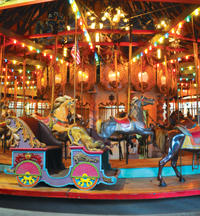Coney Island has been transforming itself for more than a century. In 1903, its most famed amusement park opened and ushered in a heyday that would run for decades. But by the turn of the millennium, the seaside enclave was a shell of itself — a run-down backwater with large swaths of vacant land and rickety rides.
Over the last decade, however, the city has invested millions to revitalize it. And developers have followed suit with a spate of residential and commercial projects now rising or on the drawing board.
The team behind Essex Crossing — the Lower East Side megaproject — has a similarly sized development in Coney Island, for example. And billionaire John Catsimatidis is building a mixed-use complex that will include a trolley line to a subway station about a mile away.
Meanwhile, Ruby Schron’s Cammeby’s International is planning a 430-foot-tall rental on Neptune Avenue that will be the tallest tower in southern Brooklyn. The firm is also building a retail and office complex, which is already 50 percent leased up. And the list goes on: PYE Properties revealed renderings in June for the hotel it’s planning (complete with a spa and banquet hall) in Coney Island’s Shore Theater.
While prices are rising, sources say the area is underserved on the retail front. What’s more, there still aren’t “a lot of the mid- to large-sized contemporary condos that we see getting built in nearby Brighton Beach and Sheepshead Bay,” said Warburg Realty agent Alex Lavrenov, who grew up in the area and works in the borough.
So the question remains, can Coney Island finally transform itself into a year-round neighborhood rather than just a destination for the Mermaid Parade and July 4 hot-dog-eating contest? Here’s a rundown of some key Coney numbers.
$14B
 The amount of economic activity the city predicted its 2009 rezoning would bring to Coney Island over 30 years. Already part of that tally is a $60 million, 5,000-seat amphitheater that opened in 2016, a restored carousel, the re-built aquarium and a 20,000-square-foot oceanfront restaurant.
The amount of economic activity the city predicted its 2009 rezoning would bring to Coney Island over 30 years. Already part of that tally is a $60 million, 5,000-seat amphitheater that opened in 2016, a restored carousel, the re-built aquarium and a 20,000-square-foot oceanfront restaurant.
6.9
The number of acres that the NYC Economic Development Corporation bought from developer Joe Sitt’s Thor Equities in 2009 to use for a revitalized amusement park. The $95.6 million sale came after years of battling between Sitt — then the area’s largest landowner — and former Mayor Michael Bloomberg. Thor still owns five acres within the city’s rezoned entertainment district.
$300M

The cost that John Catsimatidis pegged his 21-story, mixed-use development at. The 432,000-square-foot project, dubbed Ocean Dreams, will house 425 market-rate rental apartments along with retail. The developer secured a $130 million construction loan led by Bank of America in June.
1,000
The number of residential units Taconic Investment Partners and the Prusik Group plan to build at 1709 Surf Avenue, part of a three-block mixed-use development. The project, according to permits, will also include 80,000 square feet of office space and 150,000 square feet of retail.
1 in 6
The share of Coney Island’s 50,000 residents living in public housing. While Coney Island is seeing a new wave of investment, it still has a large population of low- and middle-income residents. For comparison, only one in 14 people citywide lives in a NYC Housing Authority building.
74
 The number of hot dogs that reigning champion Joey Chestnut scarfed down on July 4 to win Nathan’s Famous Hot Dog Eating Contest. The contest was broadcast on ESPN to over 1 million people, and over 20,000 people reportedly came out to watch in person.
The number of hot dogs that reigning champion Joey Chestnut scarfed down on July 4 to win Nathan’s Famous Hot Dog Eating Contest. The contest was broadcast on ESPN to over 1 million people, and over 20,000 people reportedly came out to watch in person.
$490,600
The median sales price for a home in Coney Island. Zillow estimates that prices will grow 8 percent by April 2019. By comparison, the average sales price for all of Brooklyn in 2018’s first quarter was nearly double that at about $982,000. Median rents, meanwhile, have spiked 171 percent since 2008, going to about $1,900 from $700.
10 cents
The admission price at Luna Park when it first opened. The park closed in 1944 after being ravaged by a fire. The reincarnated Luna Park charges a minimum of $40 for a day pass now. As a side note, Coney Island became home to the world’s first roller coaster — the Gravity Switchback Railway — in 1884. It was also home to the wooden Thunderbolt.
